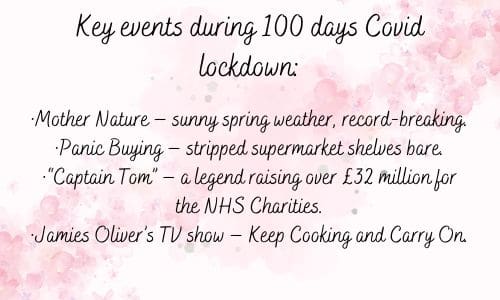Covid Lockdown: My 100 Days Lockdown 2020 Experience
Covid lockdown in 2020 was an unprecedented period in our lives across the whole globe.
When I heard the fateful word “Covid lockdown,” little did I know how much life was about to change. Like scenes from an apocalyptic movie, the streets soon emptied as an eerie hush fell over the town.
The door to our house became both my shield from the invisible enemy lurking outside and the barrier holding me captive within these four walls for 100 days Covid lockdown.
At first, I felt like Robinson Crusoe stranded on a deserted island, safe yet inexplicably alone. The definition of normalcy began to warp and twist until simple pleasures like a chat over coffee or browsing shop shelves seemed like distant memories from another lifetime.
My small living space transformed from a cosy nest into a cell and restlessness soon set in.
Yet amidst the surreal isolation, snippets of inspiration peeked through like shy wildflowers after a storm. Notes of hope sounded each evening when applause and cheers erupted to honour the heroes still out there fighting.
When this unforgettable yet unwanted chapter of history concludes, I will remember the testing of spirit and stirrings of creativity that blossomed even in the darkest days.
For now, the ticking countdown of 100 days Covid lockdown persists, but the strength of the human heart can illuminate even the longest nights.
My small world may have shrunk, but resiliency, imagination and the kindness of strangers have grown in these strange times.
The story of my 100 days Covid lockdown journey speaks of silver linings in the storm clouds, proof that light always finds a way in.
COVID-19 Lockdown
A new phrase, Covid-19, began to circulate in late November and December 2019. What exactly is that?
Coronavirus 2019 or as it became known as the COVID-19 pandemic is a killer virus that started to spread very quickly around the world.
This whole thing was becoming like a fiction novel. It reminded me of fiction novels and films of the 1950s and 1960s. In a way, like H.G. Wells’s science fiction novel “The War of the Worlds” or the 1951 film “The Day the Eart Stood Still”.
The Beginning of My 100 Days Covid Lockdown
On that fateful evening of 23rd March 2020, I sat down to watch the news on TV. As the UK’s Prime Minister, Boris Johnson, announced the first official UK Coronavirus lockdown, a whole new life opened up for millions of people across the nation.
“STAY HOME, PROTECT THE NHS, SAVE LIVES” became the slogan of the UK’s first Covid 19 lockdown.
No one could have predicted how much life was about to change. ‘Unprecedented’ was one of the most used words to describe this coronavirus pandemic during the 100 days lockdown event.
Strange and very sad times.
No one has ever been in this situation before and no one knew exactly how to react or what to do!
But what would this unfamiliar life entail for my 100 days Covid lockdown in 2020 stint? Well, it involved being confined between four walls and our back garden.
Relaxing Coronavirus Lockdown Rules
On Sunday 11th May, Boris Johnson called on people across the UK to return to work from Wednesday 14th May, if they can’t work from home.
Also from Wednesday, he said, people in the UK would be able to sunbathe in their local parks, exercise as much as they want and drive to other destinations within the UK.
The slogan changed to:
“STAY ALERT, CONTROL THE VIRUS, SAVE LIVES”.
On 23rd June Mr. Johnson set out further easing of Covid lockdown restrictions to begin from 4th July. This marked the gradual reopening of the UK.
My Creative Sanctuary: Abstract Painting
As the reality of Coronavirus lockdown quarantine set in, I yearned for an expressive outlet and welcome distraction from the dystopian news cycle.
As an abstract artist, it was probably the best thing I could do during 100 days of Covid lockdown. I decided now was the moment to cultivate a daily creative practice.
With nowhere to go and abundant time on my hands, I converted my back garden into a makeshift painting studio – a completely open space.
What began as experimentation soon became a personal sanctuary I retreated to for 7 or 8 hours each day.
I steadily worked on a series of vivid abstract acrylic paintings, along with a few abstract oil paintings. As stress melted away, I discovered a sense of flow in the process itself—the smell of paints mingling with nature’s spring blossoms, the textures forming under my brush and the colours bleeding into one another.
(I have included some of these paintings in this blog).
Beyond tangible artworks, this practice gifted me precious minutes for self-reflection and meditation away from nagging worries about the Coronavirus pandemic peak.
The 100 days Covid lockdown of repetitive creation led to an unexpectedly meditative headspace. More importantly, painting fuelled my spirit with a renewed sense of purpose.
Bold hues mirrored my resilience; textures externalised my contrasts of emotions. In spaces where words failed me, my abstract art allowed me to process this strange chapter with every paint stroke.
More than mere distraction, creating art grounded my days with meaning, an antidote for the mounting psychic toll of confinement.
As I watched my back garden come alive, I witnessed my creativity also awakening in vivid colour. Soon my makeshift studio pulsated with renewed energy and vision for brighter days ahead.
Key Events During My 100 Days Covid Lockdown
Mother Nature
In the early days of April and May, Mother Nature smiled down upon us, blessing Britain with gloriously sunny spring weather, record-breaking, the BBC declared! A small comfort during the difficult 100 days of Covid 19 pandemic lockdown.
Panic Buying
Panic buying stripped supermarket shelves bare – good luck finding a loo roll even before the first weeks of my 100 days lockdown!
Captain Tom
“Captain Tom” became a legend raising over £32 million for NHS Charities. Born on 30 April 1920, he began walking laps of his garden on 6 April 2020 to raise £1000 by his hundredth birthday.
The centenarian fundraiser Captain Tom Moore also made chart history during the 100 days of Covid lockdown by claiming the UK No. 1 spot with his rendition of the hopeful anthem “You’ll Never Walk Alone.”
At 100 years old, Captain Tom became the oldest artist ever to top the charts. Thanks to his collaboration with Michael Ball and the NHS Voices of Care Choir. Their charitable single emerged as a symbol of unity and optimism for the nation in lockdown.
Jamie Oliver
Jamie Oliver’s TV show “Keep Cooking and Carry On” was first aired on Monday 23 March 2020, the first day of my 100 days Covid lockdown. For 20 episodes over four weeks, with an episode every evening on Channel Four, Jamie Oliver showed us how to cook with limited ingredients during lockdown restrictions.
Filming the show was done by himself, his wife and his kids using a mobile phone.
The show attracted a lot of interest from a host of international broadcasters from New Zealand, North Africa, the Middle East, Australia, Hungary, Bulgaria, Russia, Poland, etc.
Downing Street Briefings
I watched the Downing Street Daily Coronavirus Briefings on TV most days during my 100 days lockdown. The daily press conferences were introduced on 16 March 2020. Initially, the briefings featured Mr. Boris Johnson, supported by medical and scientific experts including Professor Chris Whitty, Chief Medical Officer.
Mr. Motivator
As locked-down spirits needed lifting, a vibrant blast from the past danced back onto TV screens.
On 26 March, the irrepressibly energetic Mr. Motivator made a welcomed return to the BBC after years off the air.
Flaunting his signature form-fitting Lycra in eye-catching hues, this symbol of 90’s-style exercise was best known for getting Britain moving on GMTV.
Now the vibrant coach – real name Derrick Evans – funked his way back to catalyse couch potatoes during the Covid lockdown.
With high kicks and beaming smiles, he reminded us to seize each day with optimism. Mr. Motivator reemerged as an upbeat icon that reenergized the nation at a demoralising time.
Clap for Carers
Every Thursday at 8 pm, I joined millions applauding our key workers. “Clap For Our Carers” ran for 10 weeks, starting on 26th March 2020, showing support for all those working tirelessly during the UK’s 100 days lockdown.
The Drumming Weatherman
A viral moment of levity during the lockdown arrived with the Drumming Weatherman. On 15 April, weather presenter Owain Wyn Evans brought sunshine after the forecast by drumming joyously along to the BBC News theme song.
Filming himself at home after wrapping his weather report, Owain’s infectious spirit caught fire on social media.
The video exploded across news outlets from America to Australia, offering a delightful dose of optimism. For people weathering the Covid lockdown storm, the Drumming Weatherman delivered a welcome interlude of cheer that reverberated around the world.
VE Day
An uplifting moment was Dame Vera Lynn at 103 singing “We’ll Meet Again” as the UK marked the 75th anniversary of VE Day (Victory in Europe) on 8th May. Her message of hope resonated powerfully during my 100 days of Covid lockdown.
Working From Home: A Mass Exodus From The Office
As offices locked their doors, an unprecedented remote work experiment began, with over 18 million British employees adapting to working from home. Kitchen counters morphed into desks and living rooms transformed into offices overnight.
People scrambled to create functional workspaces, evidenced by nearly £2 billion spent on laptops, monitors, office chairs, printers and more.
The mass homebound workforce faced an abrupt learning curve for remote collaboration while managing endless video meetings. Daily commutes were replaced by shuffling between the computer and the fridge.
Professionals mastered balancing childcare and conference calls simultaneously. Many companies implemented flexibility to accommodate caregivers.
Staying connected with colleagues became vital for mental health, though virtual fatigue eventually set in. Remote wellness initiatives encouraged teams to take breaks for fresh air and exercise.
As much as technology enabled continuity, dealing with spotty broadband connections tested even the calmest employees. Demand exploded for IT support.
Working from home appears here to stay in some capacity moving forward. Surveys show both managers and staff favour increased flexibility rather than fully returning to crowded offices. Companies are downsizing headquarters, enticed by the overhead savings and productivity gains.
While initial adoption stemmed from necessity, working from home has unlocked convenience benefits and creative strategies.
The lockdown’s unplanned experiment demonstrated far broader possibilities for remote work than most organisations envisioned. Forced to embrace telecommuting tools during the past 100 days of Covid lockdown, Britain’s workforce discovered the model’s untapped potential.
Social Media: A Covid Lockdown Lifeline
As the reality of lockdown took hold, screens became our windows when physical doors closed. Social media exploded in popularity almost overnight, rapidly becoming a lifeline for quarantined masses.
By necessity, virtual connections replaced real-world social bonds.
What had been casual scrolling turned to compulsive checking for news of the raging crisis and any shred of cheer amidst the chaos.
- Facebook views surged more than 50% in the early weeks as housebound families and friends desperately sought to quell isolation.
- Instagram Live offerings tripled as celebrities, chefs and teachers offered free classes.
- Twitter reconsidered its capacity limits to meet demands.
- Online communities blossomed, from neighbourhood aid groups to worldwide fan clubs.
- Innovative hashtags like #LockdownLife captured this generation’s unforeseeable chapter. Video calls allowed far-flung loved ones their only face-to-face interactions for months.
And viral sensations, from dancing weathermen to centenarians fundraising by walking laps in their gardens, reminded us how even small acts can lift spirits during trying trials.
Indeed, the role of social media during the 100 days Coronavirus lockdown cannot be overstated. Rarely has clicking “Like” or leaving an emoji comment given and gotten so much in return.
When physical distancing regulations kept us 6 feet apart, the digital world brought us close again.
For all the faults of excessive screen time, we must credit social media for preserving bonds and buoying mental health when we were barely keeping our heads above water during those long 100 days of lockdown.
Online Shopping: Keeping Households Afloat
As the lockdown confined consumers to their homes, online shopping became more than a convenience—it was a critical lifeline.
With anxiety rising about risky trips to crowded shops, virtual carts replaced real ones overnight. E-commerce companies saw demand skyrocket to unforeseen heights.
Amazon struggled to keep staples like toilet paper and cleaning wipes in stock as orders for essential household items surged. Target’s online sales tripled within months.
Small businesses flocked to digital platforms to serve shut-in customers. Curb-side pickup and contactless delivery gained favour to ease safety fears.
Many consumers migrated online for necessities like food shopping for the first time, adjusting to choosing fruit virtually and trusting strangers to select bread.
Subscription services providing routine household items were hailed as heroes helping households shelter in place. A new cohort of once-stubborn technophobes got with the programme, discovering mobile apps and payment tools.
Of course, non-essential retail took a hit with department stores and many specialty shops sinking.
Yet demand swelled for diversions allowing stir-crazy families to recreate or redecorate their home spaces.
Jigsaw puzzles, baking ingredients and craft supplies flew off virtual shelves. Yeast became worth its weight in gold. Backorders for stationary bikes and treadmills signalled restless occupants seeking output for nervous energy.
All indications are that much of the massive consumer migration online is here to stay beyond the lockdown. Having trial-tested online convenience once traditional retail reopens, many are unlikely to revert to former shopping habits.
The brutal Coronavirus pandemic nearly felled many businesses, but digital commerce unquestionably emerged as an economic lifeline for both retailers and housebound customers riding out 100 days lockdown of sheltering in place.
Unleashing Inner Artists: A Surge of Pandemic Creativity
Art emerged as a breakout coping mechanism for housebound adults and children alike during the lockdown days.
What began as a boredom buster evolved into a creative outlet for self-expression and connection. Across the country, stuck-at-home novices dusted off long-abandoned hobbies or discovered hidden talents.
Online painting and crafting tutorials saw demand skyrocket. Amateur artists shared daily masterpieces on social media, wielding paintbrushes for perhaps the first time since childhood.
DIY projects boomed as people repurposed random materials into sculptures, dioramas and more. Parents unleashed their inner Michelangelo’s alongside their kids.
Musicians who typically performed at pubs and cafes took to front porches, serenading neighbourhoods from a safe distance.
Iconic cultural venues like London’s Royal Albert Hall opened their doors to virtual audiences for the first time, livestreaming concerts filmed on bare stages. The pent-up anxiety of isolation found release through humming melodies and plucking guitar strings.
This grassroots renaissance revealed creativity’s resilience even while the arts and culture sector reeled from economic freefall.
Though professional industries faced setbacks, everyday artists flourished by channelling energy into self-made projects. The do-it-yourself spirit powered people through quarantine stagnancy, unlocking inventiveness that promised to outlive Covid lockdown limitations.
(Check out my blog post – How Can I be More Creative).
In Conclusion: My 100 Days Covid Lockdown 2020
That sums up some of the key events and activities from my experience of 100 days lockdown in 2020. We lived through an extraordinary period that will be long remembered. Although challenging, there were uplifting community moments.
What are your enduring memories from your own 100 days of lockdown in 2020?
As I reflect on this unexpected 100-day sequestering, I realise that while physically confined, my mind travelled to unexpected places and discovered inner wells of fortitude.
Though stripped of externals, I found strength in simplicity and solace in abstract painting and music. My small world may have shrunk, but my heart stretched to envelop a wider community than ever before.
What about you? When your freedom was curtailed, did you connect more deeply with your inner self or with a wider world?
Did you emerge from 100 days of cocooning with a changed perspective?
I’d love to hear your lockdown stories—the ups and downs, revelations and soothings.
This generation has weathered a remarkable moment in history that called for resilience and revealed kindness in the darkest storms.
Let’s share silver linings found and continuities discovered; maybe you uncovered meaning I’ve missed.
Our shared experience shows how even enforced solitude can anchor us more firmly to each other. Covid-constrained yet creativity-unleashed, we have tales to tell from the unprecedented and unforgettable 100 days Covid lockdown in 2020.










